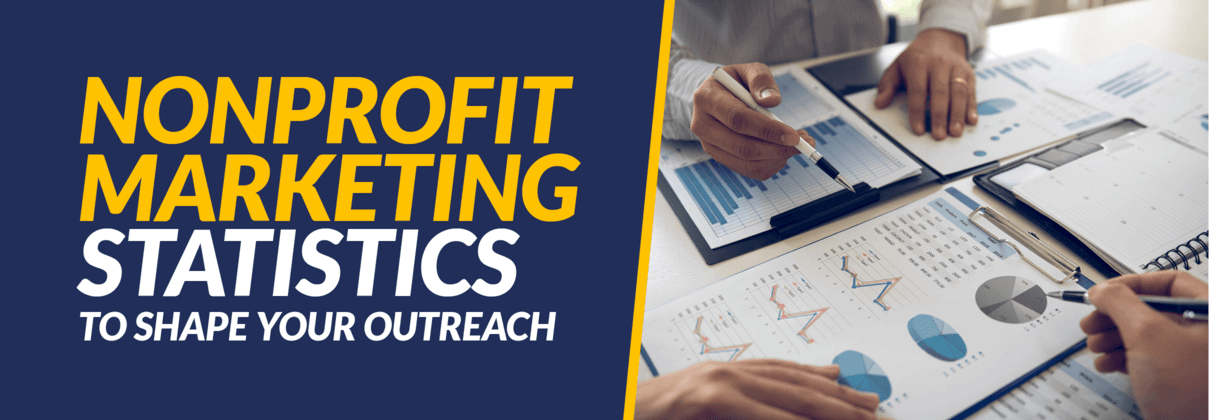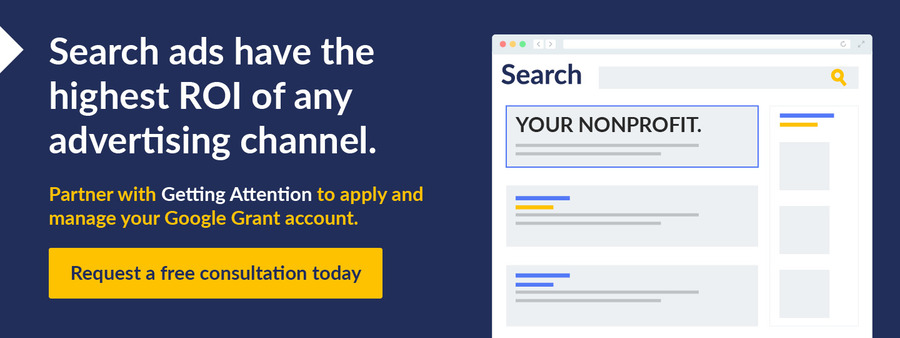45+ Nonprofit Marketing Statistics To Shape Your Outreach
As digital transformation continues to rewrite the rules of supporter engagement, nonprofits must harness the power of data to stay relevant and impactful. No matter your cause, understanding the latest nonprofit marketing statistics is more than a strategic advantage; it’s a necessity.
To help you stay ahead of the curve, we’ll share key statistics and trends that are shaping nonprofit marketing best practices this year. These insights will help you craft messages that not only reach your audience but inspire them like never before. We’ll separate this research into these key categories:
- The State of Nonprofit Marketing: Current Challenges
- General Nonprofit Marketing Statistics
- Content Marketing Statistics
- Advertising Statistics
- Social Media Marketing Statistics
- Email Marketing Statistics
- Emerging Nonprofit Marketing Trends
Let’s jump into the most compelling and informative research your nonprofit needs to know to adapt, innovate, and succeed.
The State of Nonprofit Marketing: Current Challenges
The nonprofit sector continues to evolve rapidly, influenced by technological advancements and changing donor behaviors. Understanding the current state of nonprofit marketing is crucial for organizations striving to make an impact.
Let’s explore some key challenges nonprofits are facing in their marketing efforts and the strategies they’re adopting to overcome them:
- Effectively allocating funds. Budgeting research shows that nonprofits generally allocate 5-15% of their budget to marketing. Organizations with smaller budgets should be open to spending closer to the higher end of that range. Further, despite its critical role in driving awareness and donations, marketing is often one of the first areas to see budget cuts in times of economic turbulence. Organizations tend to reassess their budgets and prioritize spending on what they perceive as essential activities, which typically excludes marketing.
- Adopting the digital-first imperative. Nonprofits resistant to change are facing challenges in reaching younger donors. While traditional methods are effective for older generations, digital channels and technologies have become essential for nonprofit marketing and operations. Even when nonprofits use direct mail, supporters frequently look online for more information. Recent studies show that 53% of U.S. consumers aged 18 to 34 reported searching for a brand online after receiving direct mail, highlighting the importance of integrating digital strategies to effectively engage younger demographics.
- Being creative. The digital space is crowded, making it hard to stand out without unique content. For your nonprofit, that might mean paying for ad space, creating emotional videos, relying on social media influencers, or formatting your donor thank-you letters as interactive eCards.
By understanding and addressing these challenges, your nonprofit can enhance its outreach, engage a broader audience, and drive greater impact in your community.
General Nonprofit Marketing Statistics
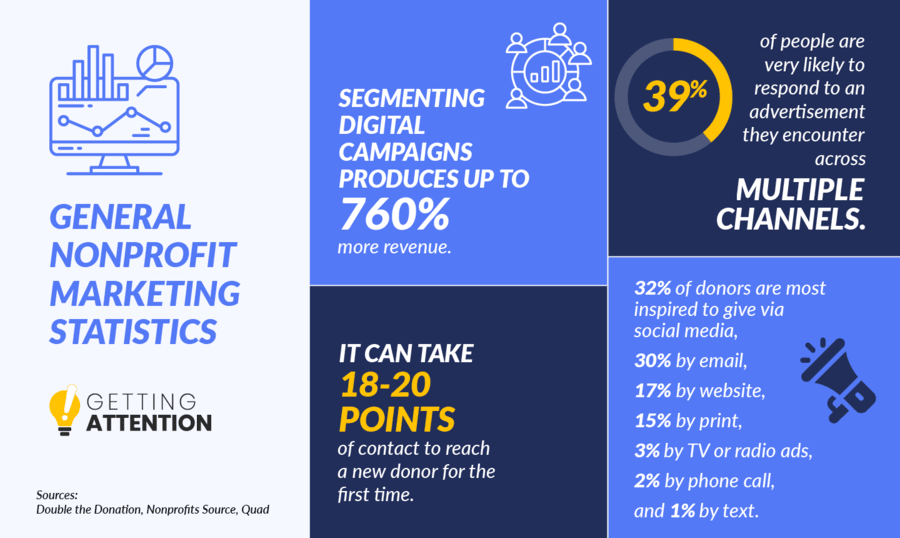
- Segmenting digital campaigns produces up to 760% more revenue compared to non-segmented campaigns (Double the Donation’s Nonprofit Fundraising Statistics).
- 32% of donors are most inspired to give via social media, followed by email (30%), website (17%), print (15%), TV or radio ad (3%), phone call (2%), and text message (1%) (Double the Donation).
- 39% of people say they’re either extremely or very likely to respond to an advertising promotion when they see it across multiple channels (Quad’s Direct Marketing Revolution Report).
- 69% of marketers agree that adding direct mail to their campaigns improves response rates (Ballantine’s Direct Mail Fundraising Guide).
- It can take 18-20 points of contact to reach a new donor for the first time (Nonprofits Source’s Online Giving Statistics).
- Combining direct mail with digital ads can yield a 28% conversion rate (Nonprofits Source).
- Nonprofits have an average of 12,708 website visitors per month (NextAfter’s Key Nonprofit Metrics).
- 52% of nonprofit website traffic comes from mobile devices, while 48% comes from desktop devices (2024 M+R Benchmarks Report).
- 28% of nonprofit websites use email subscribe popups (2023 Nonprofit Tech for Good Report).
- People remember stories 22 times more than facts alone. When you format your outreach as videos, viewers will retain 95% of your message, compared to just 10% when reading it in plain text (MemoryFox’s Storytelling Statistics).
What These Nonprofit Marketing Statistics Mean
No matter your campaign, taking a multichannel approach will ensure you reach the largest audience possible, helping to increase conversions. Just be sure to focus heavily on storytelling and personalization to boost engagement, response rates, and revenue. Since you’ll likely drive traffic to your website across these channels, ensure your website is well designed, mobile optimized, and makes it easy for users to get involved.
Nonprofit Content Marketing Statistics
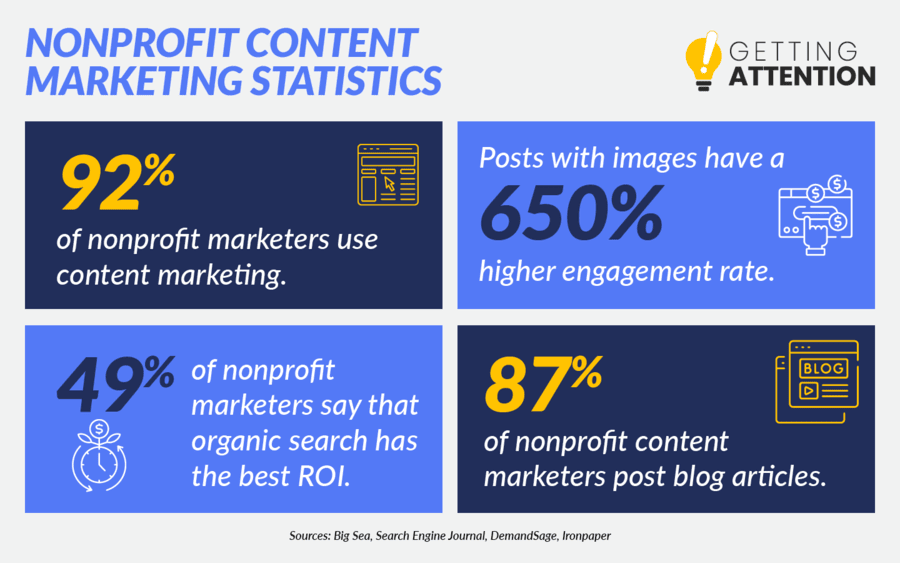
- 92% of nonprofit marketers use some form of content marketing (Big Sea’s Nonprofit Marketing Budget Guide).
- 49% of nonprofit marketers say that organic search has the best return on investment (ROI), emphasizing the value of SEO content (Search Engine Journal’s Digital Marketing Poll).
- Around 30% of marketers use infographics to present information in a visually appealing and digestible format (HubSpot’s Visual Content Marketing Statistics).
- Infographics are 30 times more likely to be read than a written article (DemandSage’s Infographics Statistics For Marketers).
- Posts with images have a 650% higher engagement rate (DemandSage).
- More than 50% of marketers agree that visual content is essential to their marketing strategy (HubSpot).
- 44% of site visits to nonprofits in an M+R Benchmarks report came from organic traffic, indicating that SEO content helps boost visibility (M+R).
- Only 37% of nonprofits have dedicated SEO strategies (Nonprofit Tech for Good).
- Wistia’s video platform reported a 15% increase in video plays and a 44% jump in watch time in 2023, indicating that video content marketing is growing more popular (Wistia’s State of Video Report).
- 87% of nonprofit content marketers post blog articles, and 64% of nonprofit content marketers do so regularly (Ironpaper’s Trends for Nonprofit Website Content).
What These Nonprofit Marketing Statistics Mean
Content marketing is more important for inspiring supporters than ever. From blog posts to case studies, your nonprofit should test different types of content to engage your audience. To catch people’s attention, integrate your written content with diverse visual content, such as infographics and videos, as these formats are ideal for message retention.
Prioritizing SEO strategies is especially crucial, yet many nonprofits overlook this channel. Create a dedicated SEO plan, complete with comprehensive keyword research, regular content updates, and authority-building strategies. You can even use Google Ads to complement your organic efforts, driving targeted traffic to your site while you build up your SEO presence and gain valuable insights into keyword performance.
Nonprofit Advertising Statistics
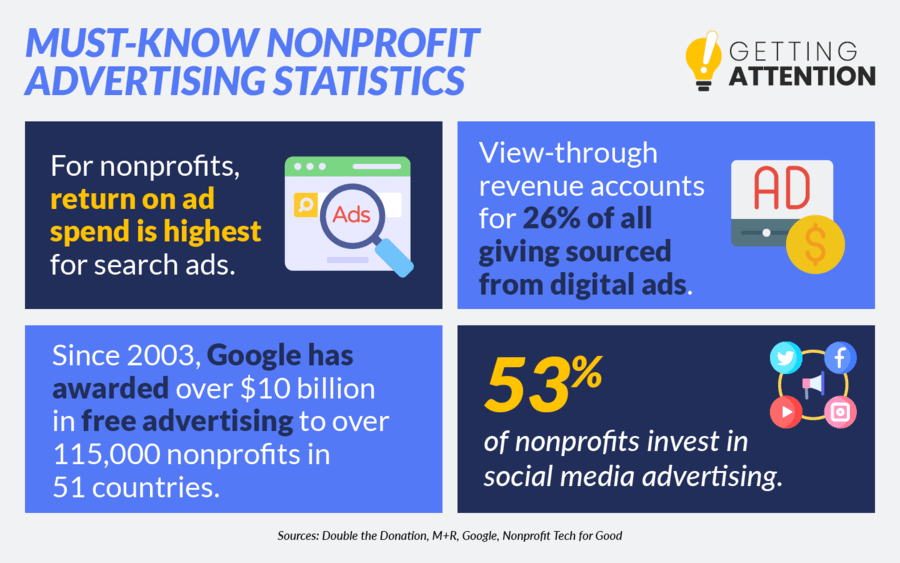
- In a recent year, nonprofits have invested 19% more in digital advertising to reach their audiences (M+R).
- Google owns over 91% of the global search engine market, helping nonprofits connect with prospects when they invest in Google Ads and SEO marketing (StatCounter).
- For nonprofits, return on ad spend was highest for search ads, at $2.75 for every dollar spent. Return on ad spend for display was $0.33, $0.50 for Meta, and $0.41 for Twitter (Double the Donation).
- View-through revenue (contributions from donors who saw but didn’t click on an ad) accounts for 26% of all giving sourced from digital ads (M+R).
- Among digital channels, search and social media spending make up a combined 80% of nonprofit advertising (M+R).
- 98% of searchers click a result on page 1 of Google, making Google Ads and SEO content effective for reaching supporters (Nonprofits Source).
- Eligible nonprofits receive up to $120,000 each year in Google Ad credits for free (Getting Attention’s Google Grant Eligibility Guide).
- Since 2003, Google has awarded over $10 billion in free advertising to over 115,000 nonprofits in 51 countries (Google Ad Grants Website).
- 53% of nonprofits invest in social media advertising (Nonprofit Tech for Good).
- Of the nonprofits that spend money on social media advertising, 98% spend money on Facebook, 47% Instagram, 17% Twitter and LinkedIn, 8% YouTube, 6% WhatsApp, and less than 1% on TikTok, Snapchat, and Twitch (Nonprofit Tech for Good).
- Print advertisements receive an average response rate of 9% (Data & Marketing Association).
- The global print advertising market is expected to reach $46.23 billion in 2024 (Statista).
What These Nonprofit Marketing Statistics Mean
Nonprofit advertising can significantly enhance your nonprofit’s visibility with target audiences, particularly through digital channels like search and social media. Leveraging tools like Google Ads not only helps nonprofits reach prospects effectively but also provides a substantial ROI.
If you haven’t already, apply for the Google Ad Grants program, which offers approved nonprofits up to $120,000 in annual ad credits, by following the steps in the video below. This generous grant can significantly boost your organization’s visibility and outreach efforts. Also, don’t hesitate to reach out if you need help applying or crafting compelling ads for your cause.
Want to learn more about this valuable opportunity to enhance your digital marketing strategy and connect with more potential donors and supporters? Check out our free Google Ad Grant Impact Report!
Social Media Marketing Statistics For Nonprofits
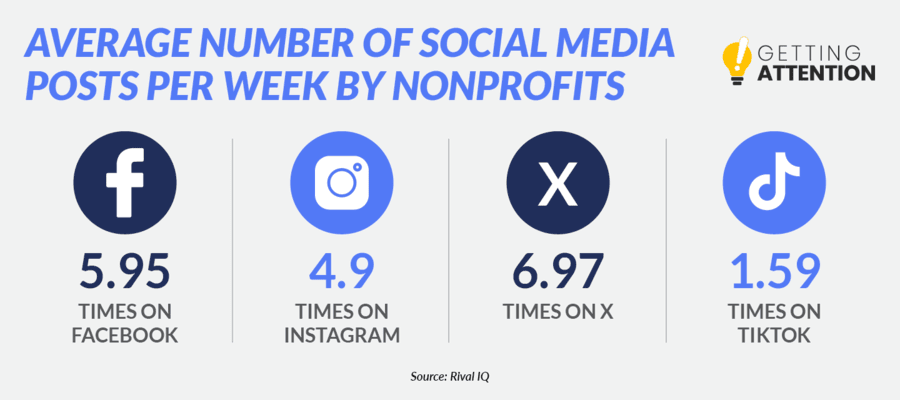
- Facebook has 3.05 billion monthly active users. 65% of these users access the site daily and spend an average of 40 minutes per day on the platform (HootSuite’s Facebook Statistics).
- By 2027, Facebook will reach 75% of the world’s population and is currently the world’s third most trafficked website after Google and YouTube (Statista and SimilarWeb).
- 96% of nonprofits have Facebook Pages (Nonprofit Tech for Good).
- 49% of nonprofits have LinkedIn Pages (Nonprofit Tech for Good).
- 73% of nonprofits worldwide use Instagram (Nonprofit Tech for Good).
- Nonprofits post an average of 5.95 times per week to their Facebook Page, 4.9 times to Instagram, 6.97 times to X (formerly Twitter), and 1.59 times to TikTok (Rival IQ Social Media Industry Benchmark Report).
- 56% of donors say that Facebook is the social media platform that has the largest impact on their decision to donate (NXUnite).
- Facebook Threads reached 1 million users quicker than any other app and earned over 100 million sign-ups in its first five days (Statista).
- There are 1 million nonprofits and 26 million nonprofit professionals on LinkedIn (LinkedIn For Nonprofits).
- In one study, about half of nonprofits reported working with influencers in 2023 (M+R).
What These Nonprofit Marketing Statistics Mean
Social media provides nonprofits with unparalleled reach and organic engagement opportunities. Platforms like Facebook, with its vast daily user base, significantly impact donor behavior, making it a key channel for driving donations. Additionally, being active on your nonprofit’s Instagram and LinkedIn allows nonprofits to connect with a broader audience, share their mission, and collaborate with influencers. Pay attention to which platforms your supporters prefer and focus your efforts on those for the best results.
Email Marketing Statistics For Nonprofits
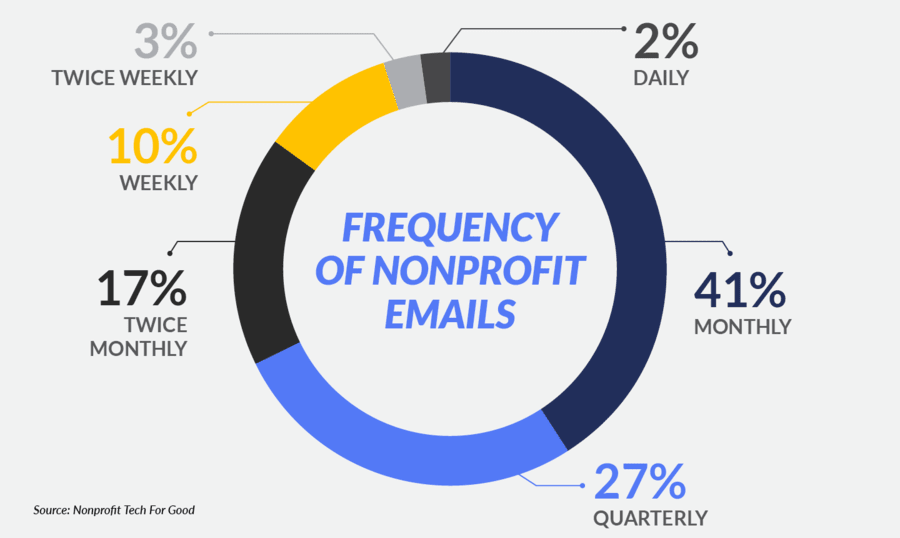
- Only 68% of nonprofits use email marketing. Of those, 41% send newsletters monthly, 27% quarterly, 17% twice monthly, 10% weekly, 3% twice weekly, and 2% daily. (Nonprofit Tech for Good).
- 74% of new subscribers expect a welcome email after joining a newsletter, and these messages have an average 202% higher open rate than traditional email campaigns (Classy’s Nonprofit Email Marketing Guide).
- In 2022, nonprofits sent an average of 60 email messages per subscriber, which was a 15% increase in volume from the previous year (M+R).
- Emails with personalized subject lines are 26% more likely to be opened. (Campaign Monitor’s Email Marketing Guide).
- Emails with preheader text have an average open rate of 44.67% while those without it only have a 39.28% average open rate (Getting Attention’s Average Nonprofit Email Open Rate Guide).
- Email-based marketing and promotional campaigns generate approximately 28% of all online nonprofit revenue (Double the Donation).
- For every 1,000 fundraising emails sent, nonprofits raise $90 on average (Double the Donation).
What These Nonprofit Marketing Statistics Mean
Email remains one of the best marketing channels for nonprofits. It offers a direct and personal way to keep supporters informed. Effective email campaigns, particularly those that are personalized and sent consistently, can significantly enhance donor relationships and increase fundraising revenue. Consider how your nonprofit can strategically use email marketing to engage supporters at every stage of their journey with your cause, whether they’ve just subscribed or are already loyal donors or volunteers.
Emerging Nonprofit Marketing Trends To Pay Attention To
It’s no secret that the nonprofit sector has been embracing digital technologies to enhance outreach. Organizations are increasingly leveraging social media, email marketing, and other digital strategies to inspire their supporters and beneficiaries. This digital shift has not only expanded the reach of many organizations but also introduced new ways to measure and enhance impact. Currently, nonprofits are focusing heavily on these current best practices:
Optimizing Nonprofit Websites
More than ever, nonprofit websites are going beyond just providing general mission information. Modern sites are focusing on these elements:
- Visual Appeal: High-quality images, engaging videos, and a clean design help capture visitors’ attention and convey the nonprofit’s mission effectively.
- User-Friendliness: Easy navigation, clear calls to action, and intuitive layouts ensure that visitors can quickly find the information they need and take desired actions, such as donating or signing up for newsletters.
- Mobile-Responsiveness: With a significant portion of web traffic coming from mobile devices, ensuring that websites are fully functional and visually appealing on smartphones and tablets is crucial for reaching a broader audience. Many nonprofits are tackling this challenge by using site builders that automatically make content mobile responsive.
- Data Privacy: Especially with changing digital data privacy laws, more nonprofits are focusing on data protection. Implementing robust data protection measures and clear privacy policies helps build trust with visitors, ensuring that their personal information is secure and handled responsibly.
- Accessibility: Improving website accessibility for people with disabilities, through features like screen reader compatibility, keyboard navigation, and text alternatives for images, ensures inclusivity and compliance with legal standards like the ADA. Generally, web designers follow the Web Content Accessibility Guidelines (WCAG), which is a comprehensive international set of standards.
Not only does prioritizing accessibility help with meeting nonprofit website requirements, but it also ensures that any potential supporters and beneficiaries can interact with their websites and get involved.
Paying For Ad Space
Today’s nonprofits find it challenging to stand out in the crowded online space, so many organizations are recognizing the power of paid advertising on non-traditional platforms. These organizations have to be thoughtful about their spending habits to avoid wasting donors’ contributions, though.
Maximizing ad ROI involves targeting specific demographics and interests, selecting the right platforms, and continuously monitoring and adjusting campaigns for effectiveness. Utilizing analytics tools can help track performance, understand user behavior, and optimize ad spend, too.
While paying for ads is out of reach for smaller organizations, many nonprofits are leveraging the Google Ad Grant to alleviate expenses and avoid misusing donations. Using this grant, nonprofits can increase their visibility on the world’s most popular search engine without incurring additional costs. That ensures that more donor funds go directly towards their mission-driven activities.
Check out this example nonprofit ad from Claire’s Place that highlights its mission, lists its services, and points Google users to key web pages to get involved:
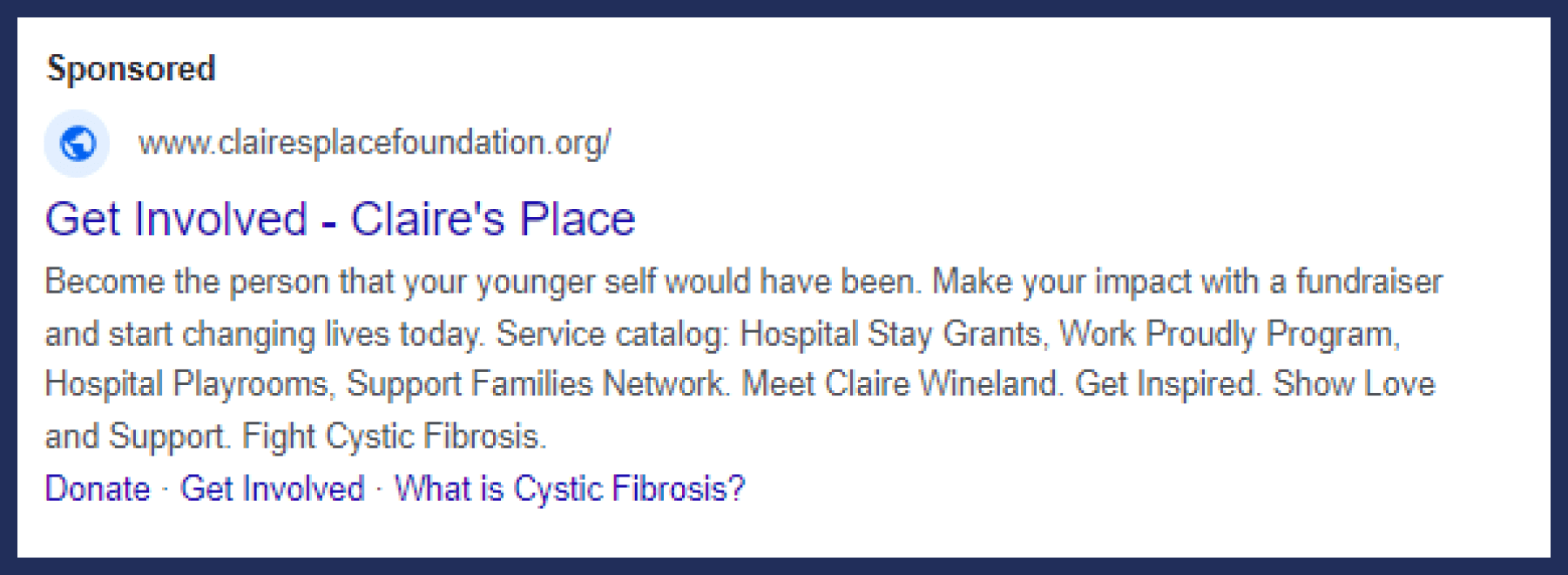
Leaning Into Visual Storytelling
Storytelling is a key strategy for inspiring support. With advancements in technology, nonprofits can now easily use powerful photography and produce compelling videos that tell those stories, form emotional connections, and resonate with web users. Modern camera technology and editing software have made creating high-quality visual content more affordable for nonprofits.
Plus, platforms like Instagram, YouTube, and TikTok prioritize visual content. By sharing engaging visual stories on these platforms, nonprofits are expanding their reach and attracting new supporters who might not be engaged through traditional methods. Follow this nonprofit marketing trend, and you’re much likelier to inspire action, too!
Personalizing Outreach
Generic messages sent to your entire supporter base aren’t enough to inspire support. Today’s consumers feel frustrated by impersonal website experiences, with 72% of people reporting that they’ll only engage with personalized messages. Luckily, technology makes this aspect of nonprofit marketing much simpler!
Nonprofits are relying on their technology to segment their supporters into meaningful groups, such as small donors, recurring donors, corporate partners, volunteers, and event participants. That way, they can send relevant engagement opportunities or updates on programs those individuals care about.
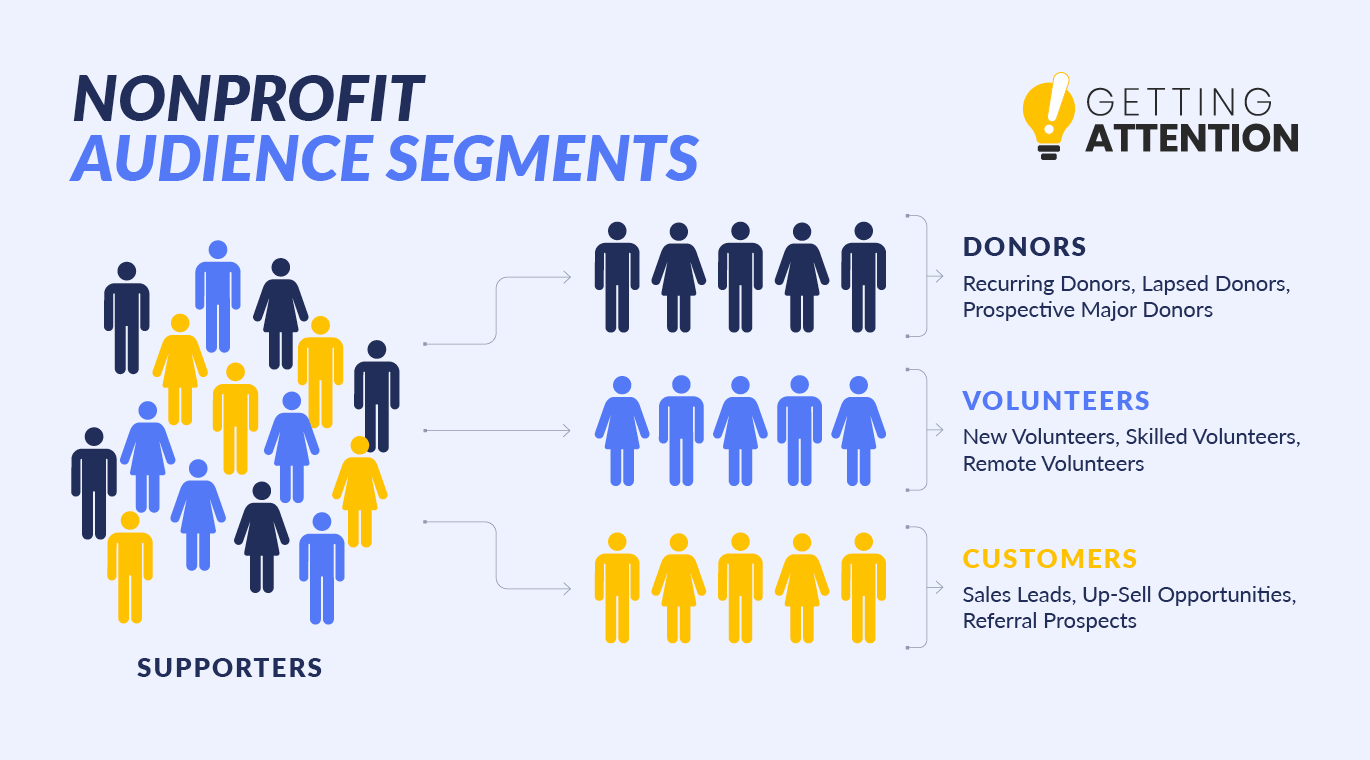
Using Generative AI
The use of generative AI is snowballing throughout digital marketing. Tools like ChatGPT can help streamline content production by producing outlines, content ideas, and even publication schedules. They can significantly reduce the time spent on routine tasks, allowing your team to focus on more strategic activities.
However, you should not rely solely on AI for content creation. Put simply, AI-generated content isn’t as user-friendly or original as human-written content. Your nonprofit marketing team understands your mission and those who will read your content unlike anyone else. Your organization’s unique voice, creativity, and insider perspectives are irreplaceable and vital for authentic engagement.
Start Tapping Into These Nonprofit Marketing Trends
Now, it’s time to put these nonprofit marketing statistics to use! As you reimagine your strategies, be open to experimenting with new marketing techniques while maintaining your core set of data-backed methods. Focus on what yields the highest ROI and remember that this doesn’t just mean immediate ROI. After all, investing in a long-term audience growth strategy is more important than instantaneous, short-term results.
To continue learning about the latest nonprofit marketing best practices, check out these resources:
- Digital Marketing for Nonprofits Made Easy: A Helpful Guide. Digital marketing continues to be one of the leading nonprofit marketing trends. Follow our advice to ensure your team is prioritizing the online landscape.
- Powerful Nonprofit Advertising Examples To Inspire Your Ads. Nonprofit ads have the power to connect you with current and new supporters. Explore real nonprofit ads to emulate, so you can maximize your return on ad spend and reach your audience.
- Worthwhile Marketing Grants for Nonprofits & How to Apply. Need additional funding in your marketing budget? Check out these grants that’ll alleviate expenses.
